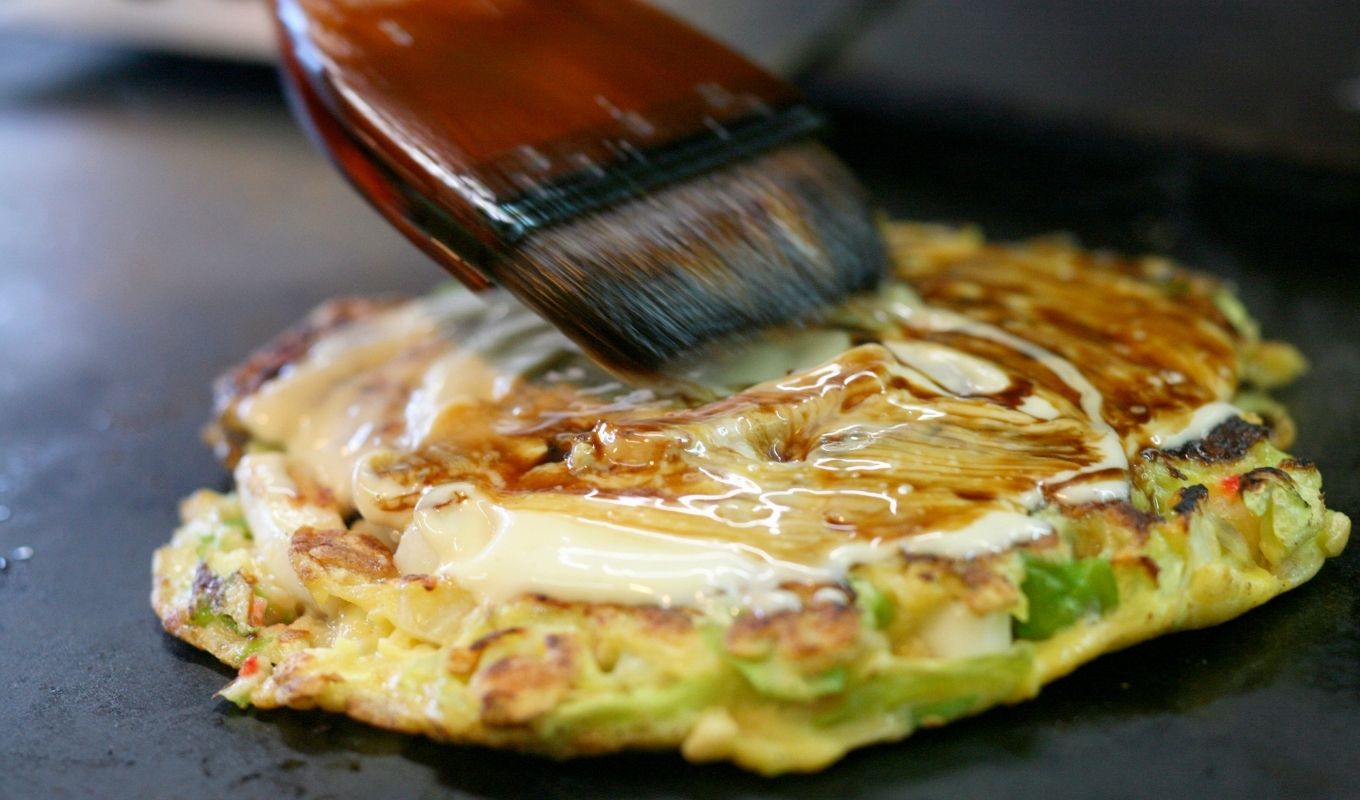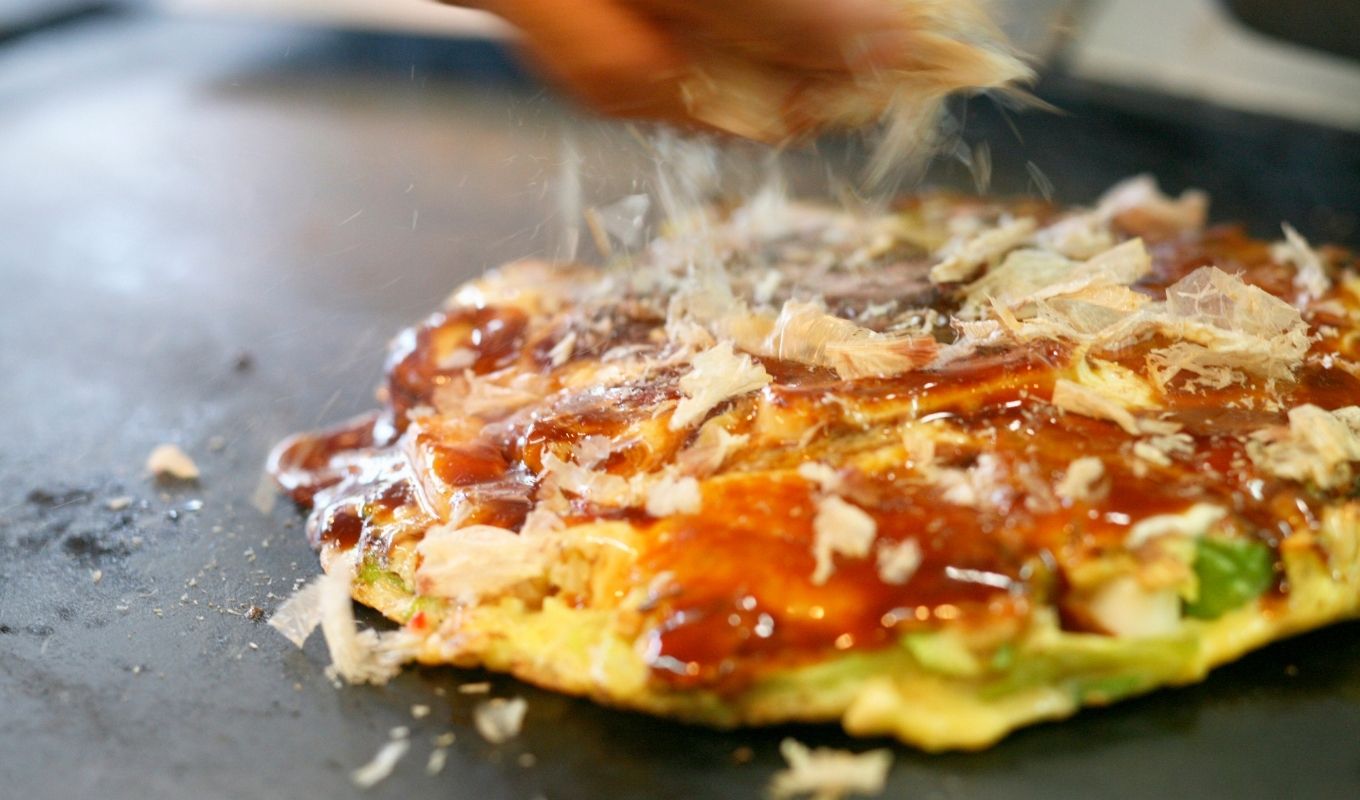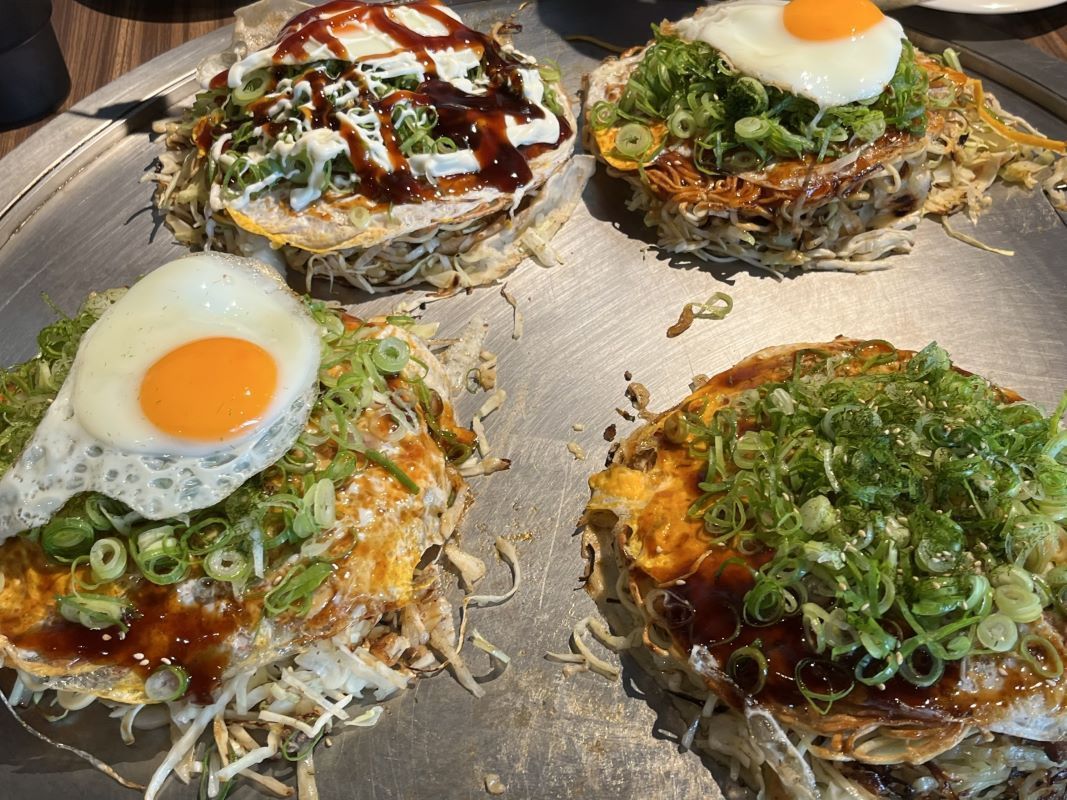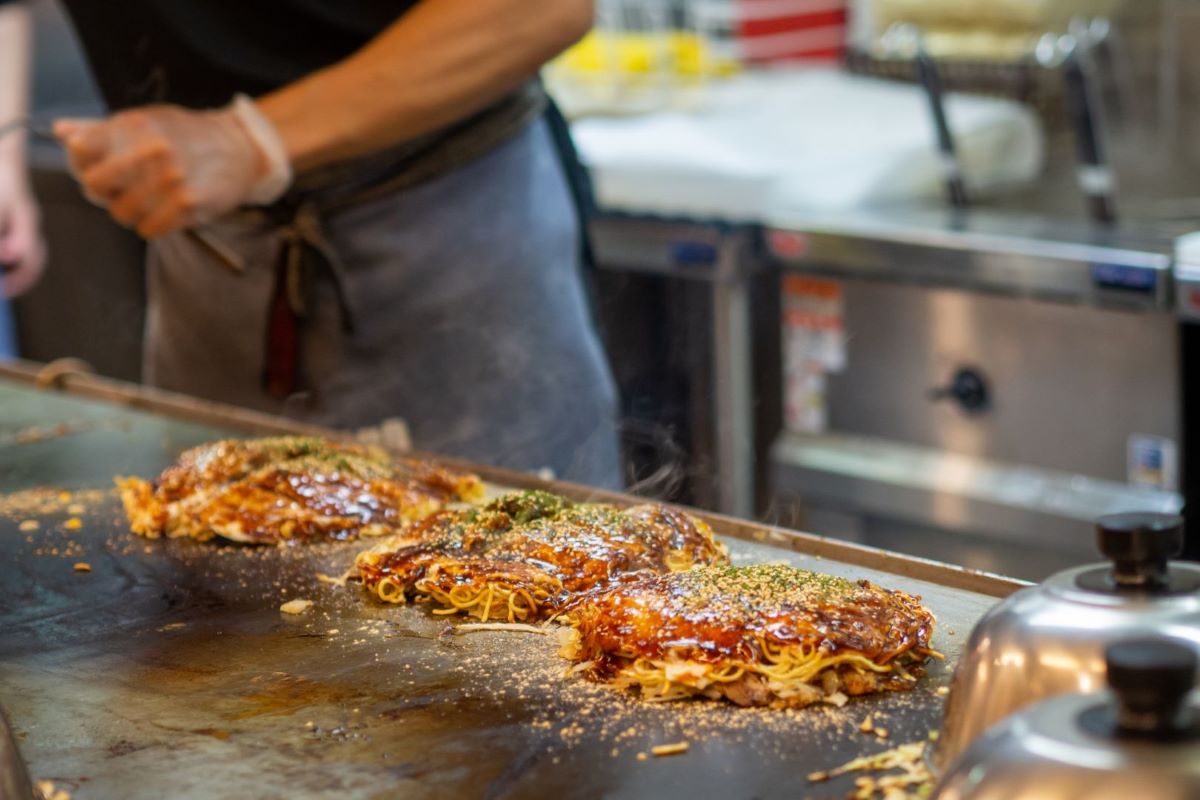Okonomiyaki is a Japanese savory pancake that has become increasingly popular around the world. The word “okonomiyaki” means “grilled as you like it,” which refers to the dish’s versatility in terms of ingredients and toppings. The dish is typically made by mixing together a batter of flour, eggs, and dashi (a Japanese soup stock), and then adding in various ingredients such as cabbage, meat, seafood, and green onions.
It is often compared to a pizza or an omelette due to its shape and the variety of toppings that can be added to it. However, the dish is unique in that it is cooked on a griddle, which gives it a crispy exterior and a soft, fluffy interior.

It’s Typically served with a variety of toppings, including okonomiyaki sauce (a thick, sweet sauce made with Worcestershire sauce), mayonnaise, dried seaweed flakes, and bonito flakes.
While okonomiyaki is a popular dish in Japan, it has also gained a following in other parts of the world, particularly in the United States. Many Japanese restaurants now offer okonomiyaki on their menus, and there are even specialty restaurants that focus solely on the dish.
History

Originally called funoyaki, it was a simple crepe-like dish made with flour, water, and grated nagaimo (a type of yam), and was often served as a snack or street food.
The modern version of okonomiyaki that we know today, however, was invented in Japan prior to World War II and evolved and became popular during and after the war. The dish was a popular way to use up leftover ingredients and was often made with cabbage, pork, and noodles.
The dish has two main regional variations, the Hiroshima-style and the Osaka-style. Hiroshima-style okonomiyaki is made by layering the ingredients on top of each other, while Osaka-style okonomiyaki mixes the ingredients together in a batter before cooking. Both styles are typically topped with a variety of sauces, including okonomiyaki sauce, mayonnaise, and bonito flakes.
Today, okonomiyaki is enjoyed by people all over Japan and around the world. It has become a staple of Japanese cuisine and is often found in restaurants and food stalls throughout the country. In recent years, there has been a growing interest in okonomiyaki outside of Japan, with many restaurants and food trucks specializing in the dish popping up in cities around the world.
Ingredients

The basic ingredients for the batter include flour, eggs, and dashi or water. However, the remaining ingredients can vary depending on personal preference and regional variations. Below are some common ingredients used in making okonomiyaki:
| Ingredient | Description |
|---|---|
| Cabbage | Finely shredded cabbage is a key ingredient in okonomiyaki. It provides a nice crunch and a slightly sweet flavor. |
| Protein | Traditionally, pork belly slices are used in okonomiyaki. However, you can use other proteins such as chicken, shrimp, or tofu to suit your taste. |
| Tenkasu | These are crispy tempura scraps that add a nice texture to the pancake. You can find them at Japanese grocery stores or online. |
| Green onion | Sliced green onions provide a nice contrast to the sweet cabbage and savory protein. |
| Okonomiyaki sauce | This is a thick and savory sauce that is similar to Worcestershire sauce. It is drizzled on top of the pancake before serving. |
| Japanese mayonnaise | This is a slightly sweeter and tangier mayonnaise compared to American mayonnaise. It is also drizzled on top of the pancake before serving. |
| Dried seaweed | This is a common topping for okonomiyaki. It adds a nice umami flavor and a bit of saltiness. |
| Dried bonito flakes | These are thin shavings of dried fish that are also a common topping for okonomiyaki. They add a nice smoky flavor and a bit of texture. |
While these are the most common ingredients used in okonomiyaki, you can also add other vegetables such as carrots, mushrooms, or bean sprouts. Some people also like to add cheese or bacon for an extra indulgent pancake. The possibilities are endless!
Preparation
Okonomiyaki is easy to prepare at home. The preparation process involves mixing the batter and ingredients, cooking the pancake, and adding toppings. Here is a step-by-step guide on how to prepare Okonomiyaki:
Mixing the batter and ingredients
The first step in preparing Okonomiyaki is to mix the batter and ingredients. The batter is made from all-purpose flour, salt, sugar, baking powder, and dashi stock or water. The ingredients can vary depending on your preference, but commonly include shredded cabbage, green onions, sliced pork belly or bacon, and shrimp or other seafood. You can also add grated nagaimo, a type of yam, to the batter for a fluffier texture.
Once you have mixed the batter and ingredients, you can heat a non-stick frying pan or griddle over medium heat.
Cooking the pancake
When the pan is hot, ladle the batter onto the pan and spread it out into a circle. Cook the pancake for 3-4 minutes on each side, or until golden brown and cooked through. You can use a spatula to flip the pancake over and cook the other side.
Some people like to add toppings to the pancake while it is cooking, such as sliced cheese or squid. You can also add additional ingredients to the batter, such as grated cheese or corn, for added flavor.
Adding toppings
Once the pancake is cooked, you can add toppings and sauces to your liking. Common toppings include mayonnaise, Okonomiyaki sauce, dried bonito flakes, and aonori seaweed. You can also top the pancake with a fried egg for added protein and flavor.
Overall, preparing Okonomiyaki is a fun and delicious way to enjoy Japanese cuisine at home. With a few simple ingredients and some basic cooking skills, you can create a tasty and satisfying meal that is perfect for any occasion.
Variations

Okonomiyaki is a versatile dish that can be customized with different ingredients and cooking methods. Here are some popular variations:
- Osaka-style: This is the most common variation, where all ingredients are mixed together before cooking. Osaka-style okonomiyaki usually includes cabbage, pork belly, and green onions. It is often topped with a sweet and savory sauce, mayonnaise, and bonito flakes.
- Hiroshima-style: This variation is layered rather than mixed together. The batter is spread thinly on the griddle, followed by layers of cabbage, bean sprouts, pork, and noodles. The ingredients are then flipped over and cooked until crispy. Hiroshima-style okonomiyaki is typically topped with a Worcestershire-like sauce, mayonnaise, and green onions.
- Tsukishima-style: This variation is a specialty of the Tsukishima district in Tokyo. It is similar to Osaka-style okonomiyaki, but with the addition of grated yamaimo (Japanese yam) to the batter. This gives the okonomiyaki a sticky texture and a slightly sweet flavor.
- Kansai-style: This is a broader term that encompasses different styles of okonomiyaki from the Kansai region, including Osaka-style and Kyoto-style. Kansai-style okonomiyaki tends to be thinner and crispier than Hiroshima-style, and often includes seafood such as squid or shrimp.
- Monjayaki: This variation is a thinner and runnier version of okonomiyaki, with a consistency similar to pancake batter. It is a specialty of the Tsukishima district in Tokyo and is typically cooked on a griddle at the table. Monjayaki is often topped with cheese, seafood, or meat.
While these are some of the most common variations, there are many other regional variations of okonomiyaki throughout Japan. Each variation has its own unique flavor and texture, making okonomiyaki a fun and customizable dish to try.
Serving and Eating Okonomiyaki
Okonomiyaki is a popular Japanese dish that is often served in restaurants that specialize in the dish. It is typically cooked on a hot plate right in front of the diners, making it a fun and interactive meal. Here are some tips on how to serve and eat Okonomiyaki:
- Use chopsticks to cut the Okonomiyaki into bite-sized pieces.
- Use a spatula to transfer the pieces to your plate.
- Drizzle Okonomiyaki sauce and mayonnaise over the top of the dish.
- Sprinkle bonito flakes and aonori seaweed over the top for added flavor.
There are different ways to eat Okonomiyaki depending on the region in Japan. In Osaka, it is common to eat the dish with a spatula and chopsticks, while in Hiroshima, it is often eaten with a small spatula and a spoon. Some restaurants also offer a variety of toppings, such as cheese or seafood, to customize your Okonomiyaki to your liking.
It is also common to enjoy Okonomiyaki with a cold beer or a glass of sake. The dish is hearty and filling, making it a great option for a satisfying meal. However, it is important to note that Okonomiyaki can be high in calories and sodium, so it should be enjoyed in moderation as part of a balanced diet.
Popular Okonomiyaki Restaurants
If you’re looking for the best places to try Okonomiyaki in Japan, here are some popular Okonomiyaki restaurants to add to your list:
Chibo
Located in the bustling Dotombori Arcade in Osaka, Chibo is one of the most popular Okonomiyaki restaurants in the city. The restaurant serves a variety of Okonomiyaki dishes, including seafood, meat, and vegetable options. Their signature dish is the “Chibo Okonomiyaki,” which is made with pork, shrimp, squid, and scallops.
Kiji
Kiji is a popular Okonomiyaki restaurant in Osaka that has been serving delicious Okonomiyaki dishes since 1960. The restaurant is known for its classic-style Okonomiyaki, which is made with cabbage, pork, and noodles. Kiji also offers a variety of toppings to customize your dish.
Mizuno
Mizuno is a long-standing Okonomiyaki restaurant in Osaka that has been serving customers for over 60 years. The restaurant is known for its “Yamaimo-yaki” Okonomiyaki, which is made with grated yam and pork. Mizuno also offers a vegetarian option made with mushrooms and cheese.
Jibunji
Jibunji is a cozy Okonomiyaki restaurant in Osaka that is popular among locals. The restaurant offers a variety of Okonomiyaki dishes, including seafood, meat, and vegetable options. Jibunji is known for its “Negi-yaki” Okonomiyaki, which is made with green onions and pork.
Okonomiyaki Sometaro
Located in Asakusa, Tokyo, Okonomiyaki Sometaro is a popular Okonomiyaki restaurant that has been serving customers for over 70 years. The restaurant is known for its classic-style Okonomiyaki, which is made with cabbage, pork, and noodles. Okonomiyaki Sometaro also offers a variety of toppings to customize your dish. These are just a few of the many popular Okonomiyaki restaurants in Japan. Be sure to add them to your list when planning your next trip to Japan.




